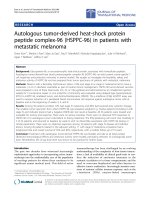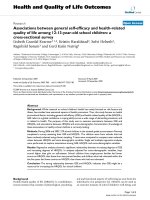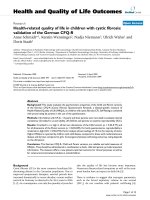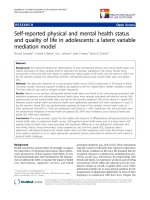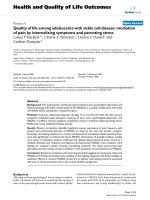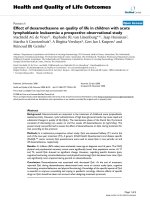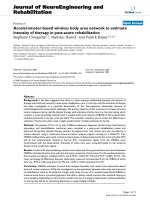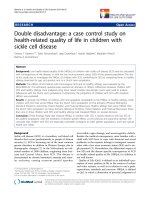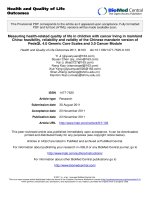báo cáo hóa học:" Double disadvantage: a case control study on health-related quality of life in children with sickle cell disease" potx
Bạn đang xem bản rút gọn của tài liệu. Xem và tải ngay bản đầy đủ của tài liệu tại đây (315.84 KB, 8 trang )
RESEARC H Open Access
Double disadvantage: a case control study on
health-related quality of life in children with
sickle cell disease
Channa T Hijmans
1,2*
, Karin Fijnvandraat
2
, Jaap Oosterlaan
3
, Harriët Heijboer
2
, Marjolein Peters
2
,
Martha A Grootenhuis
1
Abstract
Background: Low health-related quality of life (HRQoL) of children with sickle cell disease (SCD) may be associated
with consequences of the disease, or with the low socio-economic status (SES) of this patient population. The aim
of this study was to investigate the HRQoL of children with SCD, controlling for SES by comparing them to healthy
siblings (matched for age and gender), and to a Dutch norm population.
Methods: The HRQoL of 40 children with homozygous SCD and 36 healthy siblings was evaluated by the
KIDSCREEN-52. This self-report questionnaire assesses ten domains of HRQoL. Differences between children with
SCD and healthy siblings were analyzed using linear mixed models. One-sample t-tests were used to analyze
differences with the Dutch norm population. Furthermore, the proportion of childr en with SCD with impaired
HRQoL was evaluated.
Results: In general, the HRQoL of children with SCD appeared comparable to the HRQoL of healthy siblings, while
children with SCD had worse HRQoL than the Dutch norm population on five domains (Physical Well-being,
Moods & Emotions, Autonomy, Parent Relation, and Financial Resources). Healthy siblings had worse HRQoL than
the Dutch norm population on three domains (Moods & Emotions, Parent Relation, and Financial Resources). More
than one in three children with SCD and healthy siblings had impaired HRQoL on several domains.
Conclusion: These findings imply that reduced HRQoL in children with SCD is mainly related to the low SES of
this patient population, with the exception of disease specific effects on the physical and autonomy domain. We
conclude that children with SCD are especially vulnerable compared to other patient populations, and have special
health care needs.
Background
Sickle cell disease (SCD) is a hereditary red blood cell
disorder that occurs predominantly in people of African
ancestry [1]. SCD is becoming one of the most common
genetic disorders in children in Western Europe, due to
demographic changes [2]. In the Netherlands, an esti-
mated number of 1000 children, originating from Suri-
nam and Central Africa, have SCD. The disease is
characterized by chronic haemolytic anaemia and vascu-
lar occlusion, causi ng recurrent painful episodes,
irreversible organ damage, and neurocognitive deficits.
Besides the medical consequences, most families with a
child with SCD have to cope with financial and social
problems, as the majority belongs to immigrant commu-
nities with a low socio-economic status (SES) and is sin-
gle parented [3]. Nevertheless, the differential impact of
low SES and the disease spe cific consequences of SCD
on health-related quality of life (HRQoL) in children is
not well known.
Quality of Life (QoL) is defined as an individual’ sper-
ception of one’s position in li fe in the context of culture
and value systems, as well as in relation to one’sgoals,
expectat ions, standards and concerns. HRQoL is defined
as QoL in which a dimension of personal judgement of
* Correspondence:
1
Psychosocial Department, Emma Children’s Hospital, Academic Medical
Center, P.O. Box 304, 1100 VC Amsterdam, The Netherlands
Full list of author information is available at the end of the article
Hijmans et al. Health and Quality of Life Outcomes 2010, 8:121
/>© 2010 Hijmans et al; licensee BioMed Central Ltd. This is an Open Ac cess article distributed under the terms of the Creative Commons
Attribution License ( which permits unrestricted use, distribution, and reproduction in
any medium, provided the original work is properly cited.
one’s health and disease is added [4]. In the case of chil-
dren, HRQoL is also influenced by factors such as the
ability to participate in peer groups and the ability to
keep up with developmental activities. Difficulties in
measuring HRQoL in children include a l ack of consen-
sus on suitable (cross-cultural), self-report i nstruments
and the need for different instruments in different age
groups. Recently, the KIDSCREEN-52 was developed in
Europe as a g eneric, cross-national HRQoL question-
naire that evalua tes HRQoL regardless of whether chil-
dren are in good health or suffer from a chronic
medical condition [5]. This self-report questionnaire
evaluates three components of children’s well-being, in
line with the definition of HRQoL of the World Health
Organization: the physical, psychological, and social
component [4].
Previous research has evaluated psychological and
social problems in children with SCD. Although findings
were inconclusive, internalizing problems (such as anxi-
ety and depression), social problems, and feelings of low
self-esteem are commonly reported [6-10]. However, the
measurement of HRQoL, encompassing all three com-
ponents of children’s well-being, is still in its infancy in
children with SCD [11]. For example, compared to over
400 studies on HRQoL in children wit h cancer, research
on HRQoL of children with SCD is j ust scratching the
surface [12]. The relatively few studies that have been
performed revealed that HRQoL of children with SCD is
generally poor [13-18].
However, these studies have several limitations. First,
some investigators solely relied on parental ratings of
HRQoL [14,15], while self report has been described as
the ideal when measuring HRQoL [11]. Second, almost
all previous studies have been performed in the United
States of America. As the healthcare system and the ori-
gins of the p atient population in the USA differ from
Western Europe, findings from these studies ca nnot be
generalized to the European populat ion of chil dren with
SCD. Although the first study on HRQoL of children
with SCD was performed at our own institution and
showed lower HRQoL on several domains [13], this
study did not yet consider the impact of low socio-eco-
nomic status (SES) on HRQoL. Subsequent studies that
did specifically address the role of low SES yielded con-
flicting results, which can be ascribed to isolated con-
cepts of SES that were used (e.g. parental work status,
educational level, neighbourhood socioeconomic dis-
tress, or family income) [14-17]. SES is defined as a
total measure of a person’s work experience and of an
individual’ sorfamily’s eco nomic and social position
relative to others, based on income, e ducation, and
occupation. A more comprehensive approach to grasp
all these economic and sociological aspects of SES could
be to compare children with SCD to a control group of
healthy siblings with the same background. So far, no
studies on HRQoL of children with SCD have included
healthy siblings as controls. Instead, most researchers
compared children with SCD to (non-White) population
norms or to a control group with a different ethnicity or
income level.
The aim of the current study was to examine whether
reduced HRQoL in children with SCD is related to con-
sequences of the disease or to the low SES of most
patients. Therefore, we investigated self-reported
HRQoL of children with SCD compared to (1) healthy
siblings (who are comparable in age, gender, ethnicity
andSES)and(2)aDutchnormpopulation.We
hypothesized that children with SCD would have a
lower HRQoL than healthy siblings with the same back-
ground, suggesting reduced HRQoL to be related to
consequences of the disease. Alternatively, if children
with SCD and healthy siblings would have comparable
HRQoL, but childr en with SCD would have a lower
HRQoL than the Dutch norm population, this would
suggest that reduced HRQoL is related to low SES.
Methods
Participants
Forty children with SCD and 36 healthy siblings aged 6
to 18 years participated in the study. A total of 46 chil-
dren were randomly selected from the children receiving
treatment for a severe form of SCD (HbSS or HbS-b0-
thalassemia) at the Comprehensive Sickle Cell Care
Center of the Emma Children’ s Hospital, Academic
Medical Center in Amsterdam. From these 46 children,
40 (87%) participated (6 declined). Most of them had an
HbSS genotype (n = 36, 90%), the other four (10%) had
an HbS-b0-genotype. T he clinical condition of all chil-
dren with SCD was st able at the ti me the HRQoL eva-
luation took place.
After recruitment of participants with SCD, healthy
siblings of the group of participants were recruited.
Fifty-seven healthy (full or half) siblings were invited to
participate. From these, 36 (63%) participated. Siblings
were matched for age and gender one by one to partici-
pants. As no sibling match was available for all partici-
pating children with SCD, we recruited nineteen healthy
siblings (50%) in families from non-participating chil-
dren with SCD receiving care at our hospital. These
healthy siblings had similar demographic characteristics
and were matched for age and gender one by one t o
participants as well. Inclusion took place between Octo-
ber 2007 and October 2008.
Questionnaire
HRQoL was evaluated by the KIDSCREEN-52, a generic
self-report questionnaire that uses questions derived
from focus groups of children and adolescents across
Hijmans et al. Health and Quality of Life Outcomes 2010, 8:121
/>Page 2 of 8
Europe. It is applicable for both healthy and chronically
ill children and adolescents aged between 8 and 18
years. The KIDSCREEN-52 consists of 52 items asses-
sing ten domains of HRQoL during the previous week:
‘Physical Well-being’, ‘Psychological Well-being’ , ‘Moods
& Emotions’, ‘Self-Perception’, ‘Autonomy’, ‘Parent Rela-
tion & Home Life’, ‘Financial Resources’, ‘Social Support
&Peers’, ‘School Environment’ and ‘Bullying’.Itemsare
scored on a five-point scale. Within each domain, item
scores are summed and transformed to a T value. Chil-
dren in the European norm population have a mean
score of 50 with a standard deviation (SD) of 10, with
higher values indicating better HRQoL. This instrument
is validated in a Dutch population of 1960 children,
with an age distribution of 8 to 11 years (n = 641) and
12 to 18 years (n = 1270). Means of the Dutch norm
population vary across domains, but are generally 2-3
points higher than in the European norm p opulation.
The instrument has satisfactory reliability and validity
and good internal consistency [19].
Procedure
The medical ethics committee of the Academic Medical
Center of Amsterdam approved the study protocol.
Written informed consent was obtained from parents
and from children aged twelve years and older. Children
were invited to visit our outpatient clinic where the
KID SCREEN-52 was administered. Questions were read
aloud by an interviewer for children with lower reading
capabilities. Young participants received cognitive
debriefing to ascertain they understood the questions.
All children were able to comprehend the instructions
and reliably report their own HRQoL. Completion of
the questionnaire required 20 minutes.
Statistical analysis
The Statistical Package for the Social Sciences (SPSS
version 16.0) was used to manage and analyze the data.
First, missing values were handled according to the
guidelines given in the manual of the KIDSCREEN-52.
The percentage of missing data was <10%. Second, an
independent t-test and Chi square tests were used to
compare children with SCD to healthy siblings on
demo graphic characteristics. As demographic charac ter-
istics of the Dutch norm population of the KIDSC-
REEN-52 were not available, data on marital status,
educational level, and employment in the gene ral Dutch
population was obtained from the Central Dutch Bureau
of Statistics CBS . Third, linear mixed
models were used to analyze differences in HRQoL
between children with SCD and healthy siblings, and
one-sample t-tests were used to analyze differences in
HRQoL compare d to the Dutch norm population of the
KIDSCREEN-52. The linear mixed model allows for the
investigation of group differences while controlling for
the non-independency of data (i.e. more than one child
participated per family, which resulted in related mea-
surements within groups and between groups). All
doma ins were analyzed using group (patients or healthy
siblings) as fixed factor and family as random effect to
account for within family correlation.
Besides analyzing the total study sample, we per-
formed exploratory analyses separately for children aged
6-11 and adolescents aged 12-18 yea rs, as the implica-
tions of SCD for children’s social, emotional and cogni-
tive development may vary depending on the impact of
the disease at each stage of development [20]. Although
the KIDSCREEN-52 was originally designed for children
8-18 years, we included 4 children aged 6 and 8 children
aged 7 years. We explored differences in HRQoL
between children aged 6-7 (n = 12) and 8-18 years (n =
28) using in dep endent t-tests, and performed all mixed
model analyses with and without children aged 6-7
years. As no significant differences between these age
groups were found, children aged 6-7 years were
included in the final analyses.
Effect sizes (d) were calculated for differences between
children with SCD and healthy siblings, by dividing the
difference in mean score between children with SCD
and healthy siblings by the pooled SD of both groups.
According to Cohen [21], effect betwee n 0.2 and 0.5 are
considered small, effect sizes between 0.5 and 0.8 mod-
erate, and effect sizes > 0.8 large. Furthermore, we cal-
culated the point estimate of the mean difference and
confidence intervals between scores of children with
SCD and the Dutch norm population [22].
To add clinical meaning, we evaluated how many chil-
dren had impaired HRQoL scores. We followed Varni et
al who defined impaired HRQoL scores as ≥1SDbelow
the population mean [23]. The proportion of children
with SCD with scores ≥1 SD below the Dutch popula-
tion mean was compared to the proportion of healthy
siblings with scores ≥1 SD below the Dutch population
mean using Chi square test. Confidence intervals were
calculated [22] for comparison of the proportion of chil-
dren with SCD with impaired HRQoL to the proportion
of children in the Dutch norm population. In t he Dutch
norm population, 16% of children have impaired
HRQoL, based on the distribution of T values. A signifi-
cance level of p < 0.05 was used for all tests. Consider-
ing the exploratory nature of our study, we did not
correct for multiple comparisons.
Results
Demographics
Table 1 provides the demographic characteristics of chil-
dren with SCD, healthy siblings, and the g eneral Dutch
population. Children with SCD did not differ
Hijmans et al. Health and Quality of Life Outcomes 2010, 8:121
/>Page 3 of 8
significantly from healthy siblings in the distribution of
age, gender, country of origin, parental marital status,
maternal educational level or parental paid employment.
However, compared to the general Dutch population,
more children with SCD and healthy siblings grow up in
single-parent families with lower educational levels and
fewer paid employment.
HRQoL of total study sample
Results are reported in Table 2. Compared to healthy
siblings, children with SCD had significantly lower
HRQoL on only 1 domain of the KIDSCREEN-52: Phy-
sical Well-being. The effect size for t his domain was
moderate. However, compared to the Dutch norm
population, children with SCD scored significantly lower
on 5 domains: Physical Well-being, Moods & Emotions,
Autonomy, Parent Relation, and Financial Resources.
Healthy siblings also scored significantly lower on
Moods & Emotions, Parent Relation, and Financial
Resources compared to the Dutch norm population.
HRQoL of children aged 6-11
Results are reported in Table 3. Although children with
SCD aged 6-11 years had slightly lower mean scores
than healthy siblings on 8 of the 10 domains of the
KIDSCREEN-52, no statistically significant differences
were found. There was a moderate ef fect size for lower
HRQoL of children with SCD on Physical Well-being,
compared to healthy siblings. Effec t sizes for the other
domains were small.
Compared to the Dutch norm population, children
with SCD aged 6-11 years had significantly lower
HRQoL on 7 of the 10 domains: Physical Well-being,
Moods & Emotions, Self-Perception, Autonomy, Parent
Relation, Financial Resources, and Bullying . Healthy sib-
lings had significantly lower mean scores on 3 of these
domains: Autonomy, Parent Relation, and Financial
Resources.
HRQoL of children aged 12-18
Results are reported in Table 4. Adolescents with SCD
had a significantly lower HRQoL on Autonomy com-
pared to healthy siblings. The effect size for this domain
was moderate. Adolescents with SCD also had signifi-
cantly lower scores on Autonomy compared to the
Dutch norm population. No other significant differences
compared to the Dutch norm population were found.
Healthy siblings aged 12-18 years did no dif fer signifi-
cantly from the Dutch norm population either, except
for significantly lower scores on Moods & Emotions.
Table 1 Demographic characteristics of children with SCD, healthy siblings and the general Dutch population
Children with SCD
(n = 40)
Healthy siblings
(n = 36)
General population
c
Age in years, M (SD)
a
11.7 (3.1) 11.6 (3.4) - -
Boys, n (%)
a
20 (50) 18 (50) - -
Country of origin
a
Surinam, n (%) 18 (45) 23 (64) - -
West/Central Africa, n (%) 19 (48) 10 (28) - -
Turkey, n (%) 2 (5) 2 (5) - -
Netherlands Antilles, n (%) 1 (2) 1 (3) - -
Parental marital status
a
(n = 16.485)
d
Married/living together, n (%) 15 (38) 17 (47) 2.051 (81)
Single, n (%) 25 (62) 19 (53) 474 (19)
Highest level of education of mother
ab
(n = 2.039)
e
Lower, n (%) 22 (55) 19 (53) 431 (21)
Intermediate, n (%) 6 (15) 10 (28) 955 (47)
Higher, n (%) 2 (5) 1 (3) 641 (31)
Not specified, n (%) 10 (25) 6 (17) 13 (1)
Parental paid employment
a
(n = 3.928)
f
Yes, n (%) 22 (55) 23 (64) 3.787 (96)
No, n (%) 16 (40) 9 (25) 141 (4)
Not specified, n (%) 2 (5) 4 (10) - -
a
Non-significant difference between children with SCD and healthy siblings.
b
Education: Lower: elementary education, general secondary education junior-level, lower vocational education; Intermediate: general secondary education-
senior level, and vocational education-junior level; Higher: vocational education-senior level and university education.
c
Data obtained from the Central Dutch Bureau of Statistics CBS. All numbers × 10
3
.
d
Total Dutch population.
e
Total number of Dutch females aged 25-45.
f
Total number of Dutch people aged 25-45 who are part of the labour force.
Hijmans et al. Health and Quality of Life Outcomes 2010, 8:121
/>Page 4 of 8
Proportion of children with impaired HRQoL
Results are reported in Figure 1. The proportion of chil-
dren with SCD with impaired HRQoL (≥1 SD b elow the
mean) was similar to the proportion of healthy siblings
with impaired HRQoL. How ever, the proportion of chil-
dren with SCD with impaired HRQoL w as significantly
larger than the proportion in the Dutch norm popula-
tion on Physical Well-being, Moods & Emotions,
Autonomy, Parent Relation, Financial Resources, and
Bullying. Mo re than 1 in 3 children with SCD (between
30 - 38%) had impaired HRQoL on these domains,
which is a twofold increase in comparison to the Dutch
norm population (16%). The proportion of healthy sib-
lings with impaired HRQo L was also significantly larger
than the proportion in the D utch norm population on
Moods & Emotions, Autonomy, Parent Relation, and
Financial Resources.
Discussion
This is the first study to assess multidimensional
HRQoLinchildrenwithSCDusingaself-reportmea-
sure and a control group of healthy siblings. In general,
the HRQoL of childr en with SCD appeared similar to
the HRQoL of healthy siblings, with the exception of
lower scores on the physical domain for childr en with
SCD, and, specifically in adolescents, lower scores on
the autonomy domain. However, the HRQoL of both
children with SCD and healthy siblings was considerably
lower than the Dutch norm population on several
doma ins, specifically in ch ildren aged 6-11. This implies
Table 2 HRQoL of total study sample of children with SCD compared to healthy siblings and Dutch norm population
of the KIDSCREEN-52
Children
with SCD
(n = 40)
Healthy
siblings
(n = 36)
SCD versus healthy siblings Norm
population
(n = 1960)
SCD versus norm population
Mean SD Mean SD Effect size Mean SD Point estimate of mean difference (95% CI)
Physical Well-being 49 †* 8.7 54 11.4 0.5 53 10.0 -4 (-7; -1)
Psychological Well-being 53 9.3 55 9.6 0.2 53 8.8 0 (-3; +3)
Moods & Emotions 47 * 8.9 47 * 10.2 0 51 9.6 -4 (-7; -1)
Self-Perception 52 8.8 53 10.8 0.1 52 10.1 0 (-3; +3)
Autonomy 48 * 8.1 52 9.4 0.5 55 9.1 -7 (-10; -4)
Parent Relation 50 * 10.3 50 * 10.4 0 53 9.1 -3 (-6; 0)
Financial Resources 47 * 10.0 46 * 11.8 0.1 52 9.7 -5 (-8; -2)
Social Support & Peers 50 11.3 51 12.4 0.1 52 9.3 -2 (-5; 0)
School Environment 54 8.6 54 10.0 0 53 10.0 1 (-2; +4)
Bullying 45 11.5 47 11.5 0.6 49 10.4 -4 (-7; -1)
Higher scores represent better HRQoL.
† p < 0.05 children with SCD versus healthy siblings.
*p < 0.05 children with SCD and/or healthy siblings versus Dutch norm population of the KIDSCREEN-52.
Table 3 HRQoL of children with SCD aged 6-11 compared to age matched healthy siblings and Dutch norm
population of the KIDSCREEN-52
Children
with SCD
(n = 17)
Healthy
siblings
(n = 19)
SCD versus healthy siblings Norm
population
(n = 641)
SCD versus norm population
Mean SD Mean SD Effect size Mean SD Point estimate of mean difference (95% CI)
Physical Well-being 51 * 9.5 58 11.7 0.7 57 9.5 -6 (-11; +1)
Psychological Well-being 55 8.7 57 9.1 0.2 56 9.1 -1 (-5; +3)
Moods & Emotions 46 * 11.0 48 12.3 0.2 53 9.5 -7 (-12; -2)
Self-Perception 50 * 7.9 54 11.0 0.4 57 9.8 -7 (-12; -2)
Autonomy 49 * 6.8 50 * 9.4 0.1 57 8.6 -8 (-12; -4)
Parent Relation 48 * 10.4 50 * 10.1 0.2 56 8.4 -8 (-12; -4)
Financial Resources 44 * 11.8 43 * 14.2 0.1 51 10.6 -7 (-12; -2)
Social Support & Peers 53 11.7 49 13.9 0.3 53 9.1 0 (-4; +4)
School Environment 56 8.1 57 11.2 0.1 58 10.2 -2 (-7; +3)
Bullying 42 * 10.9 46 12.6 0.3 48 11.0 -6 (-11; +1)
Higher scores represent better HRQoL.
*p < 0.05 children with SCD and/or healthy siblings versus Dutch norm population of the KIDSCREEN-52.
Hijmans et al. Health and Quality of Life Outcomes 2010, 8:121
/>Page 5 of 8
that reduced HRQoL in children with SCD is primarily
related to the low SES of this patient po pulation,
although there are disease specific effects on the physi-
cal and autonomy domain.
A large study in urban elementary schoolchildren fr om
poor socioeconomic areas formerly established the essen-
tial impact that SES can have on HRQoL. These children
reported lower HRQoL than chronically diseased children
[24]. Nevertheless, prior studies in children with SCD sug-
gested that the HRQoL of children with SCD is impaired,
even after considering the potential detrimental effect of
low SES [15-17]. The contrast between these previous
finding s and the present results may be explained by the
use of different instruments, different comparison groups
and particularly the use of proxy- versus self-report. In our
study, a self-report questionnaire was administered, while
other researchers have mainly used parental proxy-report.
Parents of chronically diseased children generally tend to
report worse HRQoL for their children than children
themselves [25,26], which was confirmed by previous stu-
dies in children with SCD [13,16,17]. This may have led to
an underestimat ion of the HRQoL of children with SCD.
Parents could underestimate their children’ s HRQoL as a
result of parental distress [27]. Alternativ ely, parents and
children could have different perceptions: while childre n
may be unaware of the potential consequences of the dis-
ease, parents may have greater concerns for their future
[28] and take on a protective attitude.
Table 4 HRQoL of adolescents with SCD aged 12-18 compared to age matched healthy siblings and Dutch norm
population of the KIDSCREEN-52
Children
with SCD
(n = 23)
Healthy
siblings
(n = 17)
SCD versus healthy siblings Norm
population
(n = 1270)
SCD versus norm population
Mean SD Mean SD Effect size Mean SD Point estimate of mean difference (95% CI)
Physical Well-being 48 8.0 50 9.5 0.2 50 9.4 -2 (-6; +2)
Psychological Well-being 51 9.5 53 9.7 0.2 52 8.4 -1 (-5; +3)
Moods & Emotions 48 7.2 46 * 7.4 0.3 51 9.6 -3 (-7; +1)
Self-Perception 54 9.2 52 10.9 0.2 50 9.3 4 (0; +8)
Autonomy 47 † * 9.0 53 9.5 0.7 54 9.1 -7 (-11; -3)
Parent Relation 51 10.2 49 11.0 0.2 52 9.3 -1 (-5; +3)
Financial Resources 50 7.8 50 7.0 0 53 9.2 -3 (-7; +1)
Social Support & Peers 48 10.8 53 10.4 0.5 52 9.4 -4 (-8; 0)
School Environment 53 8.8 49 6.4 0.5 51 8.7 2 (-2; +6)
Bullying 48 11.6 49 10.5 0.1 49 10.1 -1 (-5; +3)
Higher scores represent better HRQoL.
† p < 0.05 children with SCD versus healthy siblings.
*p < 0.05 children with SCD and/or healthy siblings versus Dutch norm population of the KIDSCREEN-52.
Figure 1 Proportions of children with SCD and healthy siblings with impaired HRQoL (≥1 SD below the mean of the Dutch norm
population of the KIDSCREEN-52). The dotted line represents the 16% of children in the Dutch norm population of the KIDSCREEN-52 with
impaired HRQoL. * 95% Confidence interval of the proportion of children with SCD or healthy siblings with impaired HRQoL exceeds the
proportion in the Dutch norm population.
Hijmans et al. Health and Quality of Life Outcomes 2010, 8:121
/>Page 6 of 8
Parental (over-)protection could also underlie our
finding of lower scores of adolescents with SCD on the
autonomy domain, compared to healthy siblings. This
finding is congruent with results of a previous study in
our hospital [13] as well as othe r studies on adjustment
in adolescents with SCD [29,30], and seems to be asso-
ciated with consequences of the disease. Therefore, we
recommend that parental overprotection should be con-
sidered and targeted in intervention programs for ado-
lescents with SCD. As higher levels of self-efficacy were
previously found to be associated with fewer SCD symp-
toms [30], interventions to increase autonomy could
possibly lead to a decrease in SCD symptomatology in
this age group.
Interestingly, adolescents did not differ significantly
from healthy siblings or the Dutch norm population on
any of the other domains except for autonomy, while
children aged 6-11 did have significantly lower scores
than the norm population on 7 of the 10 domains.
Although adolescents have been described to generally
experience more problems in psychosocial adaptation
than younger children [7], HRQoL scores of adolescents
were within the normative range in a previous study as
well [27]. The resilience of adolescents could be a con-
sequence of developmental growth and adjustment, pos-
sibly causing a better coping style with increasing age.
This should be investigated further longitudinally.
Surprisingly, children with SCD did not report any
social problems. This is a remarkable contrast to the
results of previo us findings [6-10], including results of
our own work in which parents rated their children
with SCD to show less competent social behavior than
healthy siblings [31]. Further more, it is striking that
children with SCD did not report a lower HRQoL on
the School environment domain, as studies on neuro-
cognitive sequelae of SCD have shown a decrease in
general intellectual ability as well as deficits in specific
neurocognitive domains in children with SCD [32]. Chil-
dren with SCD may have adjusted to their social and
cognitive deficits and therefore do not subjectively
experience HRQoL problems in these domains. In future
research behavioural and neurocognitive data should be
correlated to HRQoL, to gain more insight into the rela-
tion between objectively identified problems and the
subjective HRQoL of children with SCD.
While interpreting the results of this study, s trengths
and limitations should be taken into account. Findings
of this study are strengthened by the use of a well-stan-
dardized self-report measure and robust statistical meth-
ods to take within family correlations into account.
Furthermore, by including a control group of healthy
siblings with the same age, ethnicity and SES, the differ-
ential effect of low SES and disease specific conse-
quences of SCD on HRQoL could be determined.
However, not all participating children with SCD had
an eligible sibling, causing us to r ecruit healthy siblings
from the entire SCD patient population. This led to an
overrepresentation of children from Surinam descent in
the healthy sibling group. Nevertheless, demographic dif-
ferences between the groups were not statistically signifi-
cant and explorative within-group analyses reveal ed no
significant differences between children from Surinam or
African descent on any of the HRQoL domains. Another
limitation was the small sample size, mitigating statistical
power. The results of our exploratory analyses need to be
interpreted within this limitation. Moreover, the current
study design did not allow us to investigate if there is an
interaction effect of SES and sickle cell disease on
HRQoL. Further limitations concerned the instrument
we used to assess HRQoL. The KIDSCREEN-52 is not
yet validated in children aged 6 and 7. However, young
participants received cognitive debriefing to ascertain
reliable self-report , and this issue was taken into acco unt
in statistical analyses. Children as yo ung as 5 years of age
have been found to be able to reliably report HRQoL
[26,33,34]. Furthermore, data were collected in a clinical
setting, which may have affected the response of the par-
ticipants. Finally, the KIDSCREEN-52 assesses HRQoL of
the past week. As SCD has a very unpredictable course, it
would be more appropriat e to assess HRQoL over longer
time periods, e.g. the past month. These issues should be
taken into account in future research.
Conclusion
Based on the present findings, we conclude that children
with SCD are primarily disadvantaged by their low SES,
causing lower HRQoL on several domains compared to
the Dutch norm population. Nevertheless, they are also
affected by specific consequences of the disease,
reflected by the lower HRQoL on the physical and
autonomy domains compared to healthy siblings. More-
over, one in three children with S CD experience
impaired HRQoL on several domains. As children with
SCD are not only affected by their disease but also by
their low SES, children with SCD seem to be especially
vulnerable compared to other patient populations, and
need specific care in the hospital. Therefore, we argue
for routine monit oring of HRQoL in children with SCD.
Incorporating patient reported outcomes of HRQoL in
daily clinical practice will contribute to better communi-
cation with health care professionals. This can provide
these children with the additional care they need due to
their double disadvan tage: a chronic disease, on top of
an unfavourable background.
Declaration of competing interests
The authors declare that they have no competing
interests.
Hijmans et al. Health and Quality of Life Outcomes 2010, 8:121
/>Page 7 of 8
Acknowledgements
The authors would like to thank all the participating children for their
willingness to participate in this study. This work was supported by AGIS
health care.
Author details
1
Psychosocial Department, Emma Children’s Hospital, Academic Medical
Center, P.O. Box 304, 1100 VC Amsterdam, The Netherlands.
2
Department of
Pediatric Hematology, Emma Children’s Hospital, Academic Medical Center,
P.O. Box 304, 1100 VC Amsterdam, The Netherlands.
3
Department of Clinical
Neuropsychology, VU University Amsterdam, Van der Boechorstst raat 1, 1081
BT Amsterdam, The Netherlands.
Authors’ contributions
CTH collected the data, analyzed and interpreted the data and drafted the
manuscript. KF designed and supervised execution of the study, interpreted
the data and drafted and revised the manuscript. JO, HH and MP supervised
execution of the study and revised the manuscript. MAG designed and
supervised execution of the study, interpreted the data and drafted and
revised the manuscript. All authors read and approved the manuscript.
Received: 31 May 2010 Accepted: 26 October 2010
Published: 26 October 2010
References
1. Stuart MJ, Nagel RL: Sickle-cell disease. Lancet 2004, 364:1343-1360.
2. Roberts I, de Montalembert M: Sickle cell disease as a paradigm of
immigration hematology: new challenges for hematologists in Europe.
Haematologica 2007, 92:865-871.
3. Van den Tweel X, Hatzmann J, Ensink E, van der Lee JH, Peters M,
Fijnvandraat K, et al: Quality of life of female caregivers of children with
sickle cell disease: a survey. Haematologica 2008, 93:588-593.
4. World Health Organization: Preamble to the Constitution of the World Health
Organization as adopted by the International Health Conference, New York,
19-22 June 1946. New York 1946.
5. Berra S, Ravens-Sieberer U, Erhart M, Tebe C, Bisegger C, Duer W, et al:
Methods and representativeness of a European survey in children and
adolescents: the KIDSCREEN study. BMC Public Health 2007, 7:182.
6. Anie KA: Psychological complications in sickle cell disease. Br J Haematol
2005, 129:723-729.
7. Barakat L, Lash LA, Lutz MJ, Nicolaou DC: Psychosocial Adaptation of
Children and Adolescents with Sickle Cell Disease. In Comprehensive
Handbook of Childhood Cancer and Sickle Cell Disease. Edited by: Brown RT.
Oxford University Press; 2006:471-495.
8. Noll RB, Vannatta K, Koontz K, Kalinyak K, Bukowski WM, Davies WH: Peer
relationships and emotional well-being of youngsters with sickle cell
disease. Child Dev 1996, 67:423-436.
9. Noll RB, Reiter-Purtill J, Vannatta K, Gerhardt CA, Short A: Peer relationships
and emotional well-being of children with sickle cell disease: a
controlled replication. Child Neuropsychol 2007, 13:173-187.
10. Trzepacz AM, Vannatta K, Gerhardt CA, Ramey C, Noll RB: Emotional, social,
and behavioral functioning of children with sickle cell disease and
comparison peers. Journal of Pediatric Hematology/Oncology 2004,
26:642-648.
11. Panepinto JA: Health-related quality of life in sickle cell disease. Pediatr
Blood Cancer 2008, 51:5-9.
12. Bonner MJ: Health related quality of life in sickle cell disease: just
scratching the surface. Pediatr Blood Cancer 2010, 54:1-2.
13. Kater AP, Heijboer H, Peters M, Vogels T, Prins MH, Heymans HSA: Quality
of life of children with sickle cell disease in the Amsterdam area.
Nederlands Tijdschrift voor Geneeskunde 1999, 143:2049-2053.
14. Palermo TM, Schwartz L, Drotar D, McGowan K: Parental report of health-
related quality of life in children with sickle cell disease. J Behav Med
2002, 25:269-283.
15. Palermo TM, Riley CA, Mitchell BA: Daily functioning and quality of life in
children with sickle cell disease pain: relationship with family and
neighborhood socioeconomic distress. J Pain
2008, 9:833-840.
16. Panepinto JA, O’Mahar KM, DeBaun MR, Loberiza FR, Scott JP: Health-
related quality of life in children with sickle cell disease: child and
parent perception. Br J Haematol 2005, 130:437-444.
17. Panepinto JA, Pajewski NM, Foerster LM, Sabnis S, Hoffmann RG: Impact of
family income and sickle cell disease on the health-related quality of life
of children. Qual Life Res 2009, 18:5-13.
18. McClellan CB, Schatz J, Sanchez C, Roberts CW: Validity of the Pediatric
Quality of Life Inventory for Youth with Sickle Cell Disease. J Pediatr
Psychol 2008, 33:1153-1162.
19. Ravens-Sieberer U, Gosch A, Rajmil L, Erhart M, Bruil J, Power M, et al: The
KIDSCREEN-52 quality of life measure for children and adolescents:
psychometric results from a cross-cultural survey in 13 European
countries. Value Health 2008, 11:645-658.
20. Gustafson KE, Bonner MJ, Hardy KK, Thompson RJ: Biopsychosocial and
Developmental Isses in Sickle Cell Disease. In Comprehensive Handbook of
Childhood Cancer and Sickle Cell Disease. Edited by: Brown RT. New York:
Oxford University Press; 2006:431-448.
21. Cohen J: Statistical power analysis for the behavioral sciences New York:
Academy Press; 1988.
22. Gardner MJ, Altman DG: Statistics with confidence London: British Medical
Journal; 1989.
23. Varni JW, Burwinkle TM, Seid M, Skarr D: The PedsQL 4.0 as a pediatric
population health measure: feasibility, reliability, and validity. Ambul
Pediatr 2003, 3:329-341.
24. Mansour ME, Kotagal U, Rose B, Ho M, Brewer D, Roy-Chaudhury A, et al:
Health-related quality of life in urban elementary schoolchildren.
Pediatrics 2003, 111:1372-1381.
25. Eiser C, Morse R: Can parents rate their child’s health-related quality of
life? Results of a systematic review. Qual Life Res 2001, 10:347-357.
26. Varni JW, Limbers CA, Burwinkle TM: Parent proxy-report of their
children’s health-related quality of life: An analysis of 13,878 parents’
reliability and validity across age subgroups using the PedsQL 4.0
Generic Core Scales. Health and Quality of Life Outcomes 2007, 5:2.
27. Barakat LP, Patterson CA, Daniel LC, Dampier C: Quality of life among
adolescents with sickle cell disease: mediation of pain by internalizing
symptoms and parenting stress. Health Qual Life Outcomes 2008, 6:60.
28. Eiser C, Morse R: Quality-of-life measures in chronic diseases of
childhood. Health Technol Assess 2001, 5:1-157.
29. Anie KA, Telfair J: Multi-site study of transition in adolescents with sickle
cell disease in the United Kingdom and the United States. Int J Adolesc
Med Health 2005, 17:169-178.
30. Clay OJ, Telfair J: Evaluation of a disease-specific self-efficacy instrument
in adolescents with sickle cell disease and its relationship to adjustment.
Child Neuropsychol 2007, 13:188-203.
31. Hijmans CT, Grootenhuis MA, Oosterlaan J, Last BF, Heijboer H, Peters M,
et al: Behavioral and emotional problems in children with sickle cell
disease and healthy siblings: Multiple informants, multiple measures.
Pediatric Blood and Cancer 2009, 53:1277-1283.
32. Schatz J, Puffer E: Neuropsychological Aspects of Sickle Cell Disease. In
Comprehensive Handbook of Childhood Cancer and Sickle Cell Disease. Edited
by: Brown RT. New York Oxford University Press; 2006:449-470.
33. Feeny D, Furlong W, Boyle M, Torrance GW: Multi-attribute health status
classification systems. Health Utilities Index. Pharmacoeconomics 1995,
7:490-502.
34. Juniper EF, Guyatt GH, Feeny DH, Griffith LE, Ferrie PJ: Minimum skills
required by children to complete health-related quality of life
instruments for asthma: comparison of measurement properties. Eur
Respir J 1997, 10:2285-2294.
doi:10.1186/1477-7525-8-121
Cite this article as: Hijmans et al.: Double disadvantage: a case control
study on health-related quality of life in children with sickle cell
disease. Health and Quality of Life Outcomes 2010 8:121.
Hijmans et al. Health and Quality of Life Outcomes 2010, 8:121
/>Page 8 of 8
